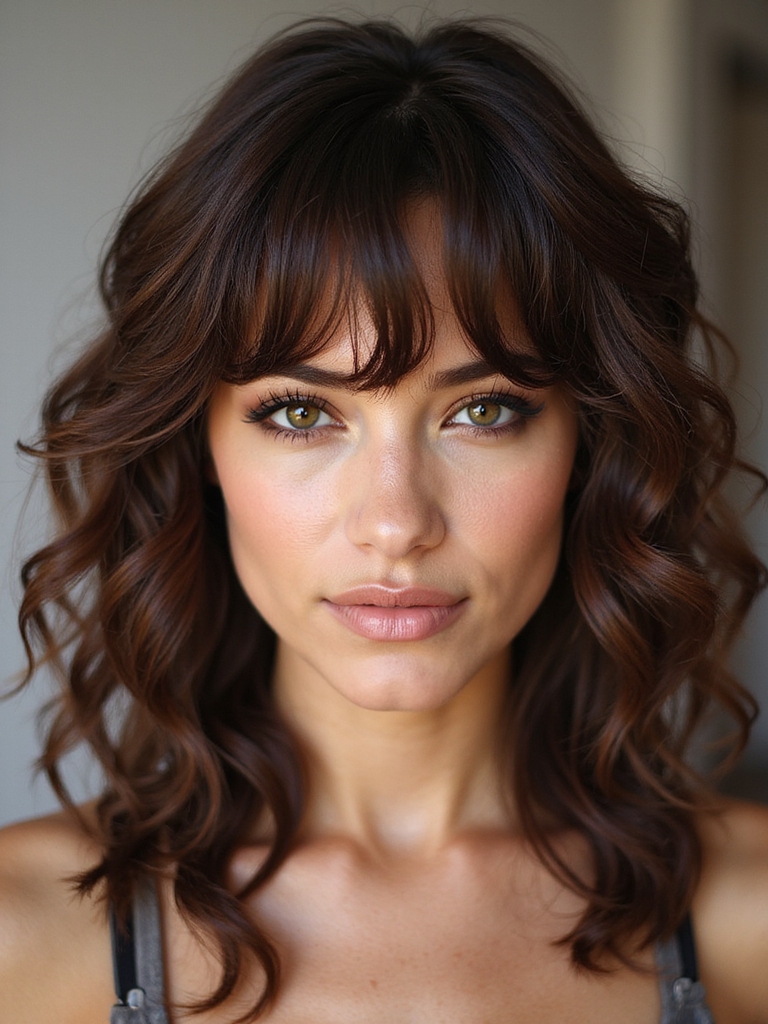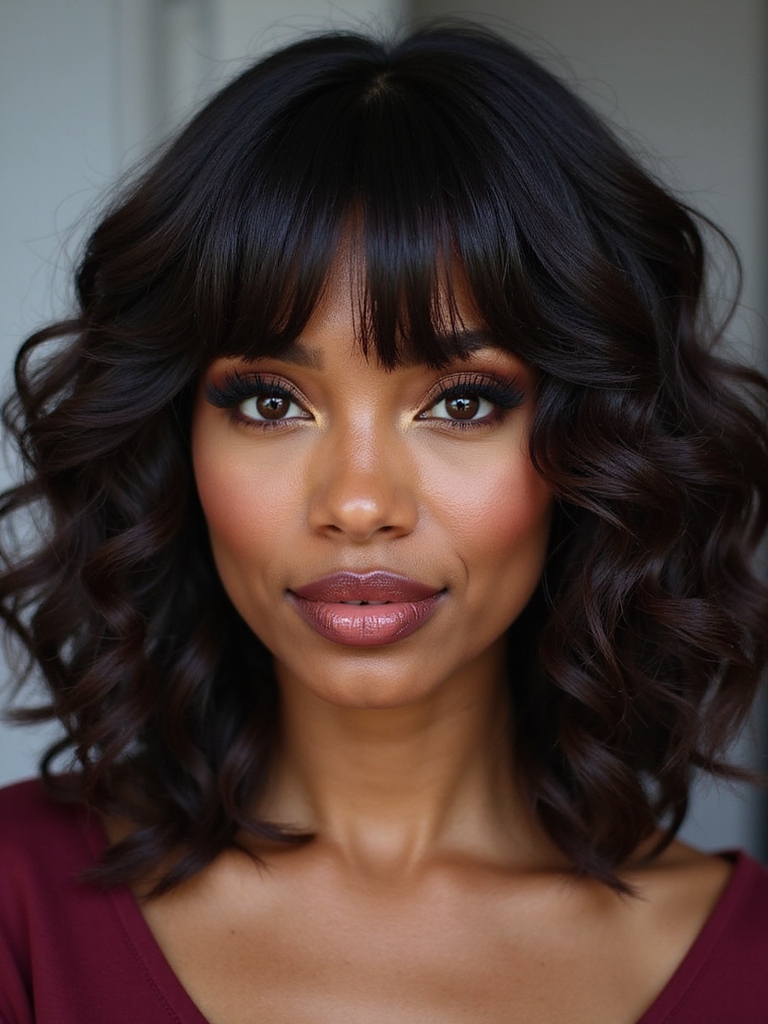I love how curtain bangs can frame curly hair without flattening it, and I’ll show you how to get that springy, touchable look without sacrificing movement. From shaping to length and the tiny internal layers that make curls pop, there are simple tweaks that change everything — plus nightly and styling habits that keep them bouncy.
Stick with me and we’ll sort out what works for your curl type so you can wear them with confidence.
Why Curtain Bangs Work for Curly Hair

Knowing a bit about texture and movement, I can tell you curtain bangs are a game-changer for curly hair.
I love how they frame the face without weighing curls down, adding soft shape and controlled bounce. They let natural ringlets breathe, reduce bulk around the forehead, and offer effortless style.
Believe me — they boost freshness and playfulness with minimal fuss. Curly curtain bangs also create a soft, face-framing silhouette that enhances natural curl patterns.
Choosing the Right Curtain Bang Shape for Your Curl Type

Because curl patterns vary so much, I always start by matching the curtain bang shape to your specific curl type—whether you’ve got loose waves, defined spirals, or tight coils.
I recommend softer, longer layers for waves, tapered, face-framing lengths for spirals, and shorter, chunkier panels for coils.
We’ll tweak density and length so bangs sit lightweight, springy, and flattering to your face.
Curly curtain bangs also benefit from styling that enhances natural movement, especially when cut to complement curly hair styled with curtain bangs.
How to Section Hair for a Balanced Cut

When I section hair for curtain bangs, I start with clean, dry curls so I can see each strand’s natural fall and spring; this lets me place panels that read balanced if hair’s stretched or released.
I create a soft center part, carve two triangular bang sections, and clip the rest back. I check symmetry by tilting the head and adjusting thin face-framing slices. Curtain bangs are a soft, flattering option that complements many face shapes and curl patterns, especially when cut to enhance your natural movement and face-framing layers.
Cutting Techniques That Preserve Spring and Movement

Tapping into the curl’s natural rhythm, I cut with tiny, intentional snips rather than long, blunt strokes so each strand keeps its spring and bounce.
I point-cut to soften edges, release tension with slide-cutting for movement, and trim curls dry to see true shape.
I check balance curl-by-curl, conserving length where coils need weight, letting natural pattern dictate the final silhouette.
Effortless long layers and soft curtain bangs create a light, flowing frame that enhances curl definition and movement by reducing bulk where needed and preserving length where it helps the coil spring back.
Length Guidelines for Different Curl Patterns

Now let’s talk about how length plays out across curl types so your curtain bangs land where you want them.
I’ll explain how to match the cut length to your curl pattern and account for shrinkage so the bangs’ final length looks right when dry.
Stick with me and we’ll pick a starting point that keeps shape, movement, and your face framing in balance.
Straight hair often uses longer starting lengths for curtain bangs to prevent them from falling flat, so consider techniques used for Curtain Bangs Straight Hair when planning your initial cut.
Match Length to Curl
I’ve learned that the right bang length can make or break how your curls behave, so I’ll help you match length to curl pattern for the best shape and bounce.
For looser waves, keep curtain bangs shoulder-grazing to frame without flattening. For tighter coils, opt for longer bangs that sit below the brow to preserve spring and avoid constant re-tugging.
Shrinkage and Final Length
Matching bang length to curl pattern sets you up well, but shrinkage is the curveball that actually decides the finished look — I always check how much your curls spring up when wet versus dry before cutting.
I measure curl springback, estimate final fall, and recommend leaving a bit longer for tighter coils. That way your bangs bounce into the perfect, flattering length without surprises.
Layering Tips to Prevent Heaviness and Bulk

Because curly bangs can quickly feel heavy at the crown or bulky at the ends, I’ll walk you through simple layering tricks that keep bounce and definition without removing texture.
I favor soft, face-framing layers and selective thinning to let curls spring.
Try these techniques at home or with your stylist:
- Dust ends for lightness.
- Short interior layers for lift.
- Long outer layers for shape.
How to Avoid Common Cutting Mistakes

When you’re ready to trim or reshape your curly curtain bangs, don’t rush—mistakes happen fast with textured hair, and I’ll help you sidestep the usual ones.
Work on dry, defined curls, snip conservatively, avoid slicing across a heavy arc, and resist over-thinning.
Check symmetry with your natural part, take breaks, and reassess.
Small tweaks keep bounce intact and prevent surprises.
Products That Enhance Bounce and Definition

Now that we’ve covered cutting, I want to talk about the few products that actually make your curtain bangs pop.
I swear by a lightweight curl cream to boost bounce without weighing curls down, and a humidity-resistant hairspray to lock in definition when the air gets rebellious.
Stick with those two and you’ll keep shape and movement all day.
Lightweight Curl Cream
For curly curtain bangs, I reach for a lightweight curl cream that enhances bounce without weighing my hair down; it gives definition, fights frizz, and keeps those delicate front curls soft and touchable.
I apply sparingly to damp bangs, scrunching gently.
- Smooths strands
- Boosts spring
- Adds subtle hold
Humidity-Resistant Hairspray
I usually finish my curtain bangs with a humidity-resistant hairspray because it locks in bounce and definition without turning my hair crunchy.
I mist lightly from a distance, scrunching gently to keep movement.
It tames frizz on humid days, boosts hold for natural shape, and revives curls between washes.
Choose a flexible, lightweight formula so your bangs stay soft and lively.
Styling Methods for Day-One Curls

Usually I reach for a lightweight leave-in and a small amount of gel to define my day-one curtain bangs without weighing them down. I scrunch gently, set with diffuse heat if needed, and finish by separating strands for movement.
Quick, simple steps keep bounce.
- Scrunch and squeeze excess product
- Diffuse on low heat
- Finger-separate for natural parting
Refreshing Bangs Between Wash Days

Keeping those day-one curls alive sometimes means a little midweek rescue for my curtain bangs, and I’ll show you how I bring them back without a full wash.
I spritz a curl refresher or diluted conditioner, scrunch gently to revive shape, tame frizz with a tiny bit of leave-in, and clip roots briefly to boost lift.
Quick, no-rinse fixes keep bounce.
Heat Tools and When to Use Them Sparingly

Since heat can do more harm than good when overused, I reach for my flat iron or blow dryer only when a look really needs their help—like smoothing stubborn frizz or setting a face-framing shape that won’t hold on its own.
I use heat sparingly, protect strands, and prefer air-drying mostly.
- Low heat, quick passes
- Heat protectant always
- Targeted styling only
Transitioning to Curtain Bangs From a Full Bang

If you’re ready to move from a full bang to curtain bangs, I recommend easing into it by trimming a little bit at a time so you can watch the shape emerge.
I’d my stylist reduce the length gradually and add soft layers through the fringe to create natural movement and avoid a choppy look.
With small cuts and strategic layering, your curls will fall into that effortless curtain shape without a dramatic shock.
Gradual Length Reduction
I start by easing length off my full bangs in small, deliberate cuts so the change feels natural instead of dramatic.
I check curl fall and symmetry as I go, trimming a little more only when comfortable.
- Snip center shorter for parting guidance.
- Clip sides slightly longer to frame.
- Reassess after drying to tweak balance.
Layering for Movement
Let’s add some lightness: I start layering my full bangs to create movement and let each curl breathe, cutting short, feathered layers that won’t fight my natural fall.
I part gently, trim into soft curtain shapes, and remove weight from the middle so sides swing. It’s playful, practical, and keeps curls defined without stiffness—easy daily bounce.
Working With a Stylist: What to Ask for

Wondering how to get the curly curtain bangs you actually want? I tell my stylist I want face-framing layers, soft weight removal (not razor-thinned), and a wet-look trim so curls spring correctly.
I ask for demo styling and product recs, too — helps me recreate it at home.
- Show reference photos
- Request dry cutting
- Ask product specifics
Caring for Curtain Bangs While Sleeping and Exercising

Sleeping and moving with curtain bangs doesn’t have to mean morning frizz or sweat‑flattened bangs — I treat it like part of my routine so they stay bouncy and defined.
At night I pineapple loosely, use a silk pillowcase, and refresh with a light mist.
For workouts I pin bangs up or wear a headband, then diffuse or scrunch in a tiny curl cream afterward.
When to Trim or Reshape Your Curtain Bangs

I’ll tell you how to know when your curtain bangs need a trim—think heavy curl weight, bangs poking into your eyes, or your part disappearing.
Sometimes it’s just a tiny tidy-up, but other times reshaping to flatter your face (shortening the center or softening the sides) makes all the difference.
I’ll walk you through quick timing cues and simple reshaping ideas so you can keep them looking fresh between salon visits.
Trim Timing Cues
Often I check my curl line and feel it’s time for a tidy — curtain bangs give little warnings before they need reshaping.
I watch for weight, uneven swing, and when bangs start hiding my eyes.
I trim small amounts or book a pro.
- Heavy bottoming
- Loss of shape
- Eye coverage
Reshape for Face
When my curtain bangs start looking like they’re doing their own thing, I check how their length and parting complement my cheekbones and forehead — that tells me if it’s time to trim or fully reshape.
If they hide my features or flare awkwardly, I’ll soften the edges or rework the curve. I prefer small tweaks at home and major reshapes with my stylist.
I’m so glad you explored curtain bangs with me — they’re a fun, face‑framing way to let your curls shine without feeling heavy. Start with a shape that suits your curl pattern, ask your stylist for dry cutting and light internal layers, and protect your bounce with pineapple nights and a silk pillowcase.
Trim small bits as needed, style softly with curl cream and scrunching, and enjoy that playful, effortless volume every day.







